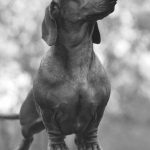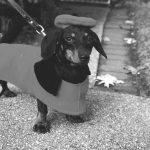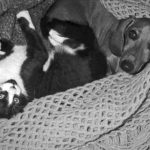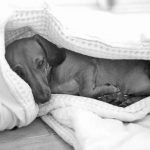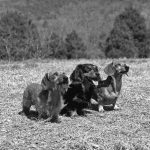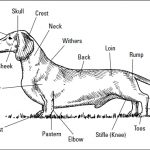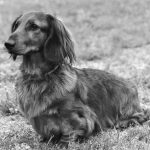Teaching Your Dachshund the House Rules
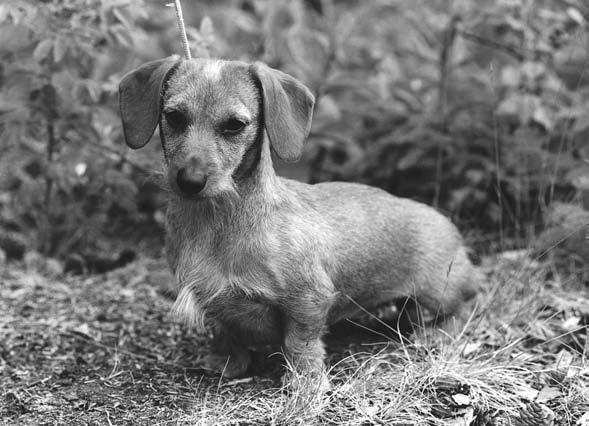
- Housebreaking your Dachsie
- Nipping puppy biting and chewing in the bud
- Dealing with that Dachshund bark, bark, bark
- Teaching your puppy not to jump
- Working with an old dog on new tricks
You’ve been worrying about training your new Dachshund, haven’t you? What new dog owner doesn’t? Bad behavior is a major cause of puppy and dog abandonment to animal shelters, and the saddest part is that the puppies and dogs aren’t even to blame. They pay the price for their owners’ lack of knowledge and commitment to preventing and dealing with behavior problems in the first place.
Housetraining 101
Understanding the elimination process
Your detailed guide to housetraining
Tip
If you decide to paper-train your Dachshund — or, like one senior owner I know, allow him to use the extra shower stall as his “litterbox” — the same guidelines apply, except that you whisk him off to his inside elimination station.
– Before bringing your puppy inside the house for the very first time, take him to his elimination station while he’s still attached to his leash and stay there until he does his duty.
If he won’t eliminate, take him inside, put him in his den, close the door, and tell him in a gentle voice that you’ll be back. Return in 15 minutes and try again. Don’t take him anywhere else in the house until he has eliminated in his special spot.
– Every two hours during the day for the first week, take him out to his special spot.
If he doesn’t go, bring him in and put him in his den (nicely — don’t get mad or none of this will work). Return every 20 to 30 minutes and try again until he goes. (Note: Your puppy may have a stronger bladder, and you may find that you can take him out every three or four hours rather than every two. But start with two-hour intervals until you know your Dachshund’s tendencies.)
Tip
If you have to work all day and nobody will be home, have someone come by every few hours to let out your puppy. If you can’t find a willing friend or family member, consider hiring a pet sitter. These professionals spend much of their days walking and playing with puppies and adult dogs for people who can’t get home from work for long periods of time.
– Within 30 minutes of a meal, take him outside until he goes.
After you learn your puppy’s e-time (see the section “Timing is everything”), you can alter this step to fit your puppy’s needs.
– For the first week, take your puppy out every four hours during the night.
Set your alarm if you have to, but your Dachshund will probably wake you up. (If he’s sleeping soundly, you can wait it out, but don’t miss the opportunity when he wakes up.)
– Always take your puppy out first thing in the morning, at the same time each morning, and immediately before bedtime, at the same time each evening.
Sorry, that means on weekends, too! Continue this habit throughout your Dachshund’s life. (You can always go back to bed after the bathroom break.)
– Never, ever miss the sniff-and-circle routine.
If you or someone else can’t watch him, let your puppy rest in his crate where he’ll be much less likely to have an accident.
For the first couple of weeks, be extra vigilant. It could happen any time, even when an elimination session isn’t scheduled. After your Dachshund is housetrained, keep the concept in the back of your mind. Everyone forgets about letting the dog out every now and then. And note that after an extra-big meal, your Dachshund may need more outside time than usual.
– For the first couple weeks, keep your Dachshund in uncarpeted areas whenever he’s out of his den.
Cleanup will be much easier, and the scent won’t last like it will in carpet. (Purchase a reliable odor remover specifically designed for pet odors; see Chapter Purchasing Your Dachshund Essentials.)
– If your Dachshund makes a mistake, remember that it’s your fault, not your Dachshund’s.
Don’t get mad. You can behave with urgency when whisking your Dachshund outside if you catch him in the act. You can say “No!” sternly and even sharply, which may interrupt him mid-accident so you can get him outside before he finishes. But don’t yell at him (even if you’re extremely irritated, which you very well may be), and for your dog’s sake, don’t hit him or rub his nose in his transgression (or, I should say, your transgression). He won’t get it. He really won’t. It will just make things worse, and he’ll learn to fear you.
Tip
To help you keep track of when to take your Dachshund outside in the first week, make a copy of Table 13-1 (or make your own version) and circle the appropriate time of each successful elimination. The chart lists times in two-hour intervals throughout the day and fourhour intervals throughout the night, assuming that your Dachshund gets up at 7 a.m. and goes to bed at 11 p.m. Times are approximate. Modify them for your own schedule.
Table 13-1 Daily Elimination Schedule | ||||||
Monday | Tuesday | Wednesday | Thursday | Friday | Saturday | Sunday |
7 a.m. | 7 a.m. | 7 a.m. | 7 a.m. | 7 a.m. | 7 a.m. | 7 a.m. |
9 a.m. | 9 a.m. | 9 a.m. | 9 a.m. | 9 a.m. | 9 a.m. | 9 a.m. |
11 a.m. | 11 a.m. | 11 a.m. | 11 a.m. | 11 a.m. | 11 a.m. | 11 a.m. |
1 p.m. | 1 p.m. | 1 p.m. | 1 p.m. | 1 p.m. | 1 p.m. | 1 p.m. |
3 p.m. | 3 p.m. | 3 p.m. | 3 p.m. | 3 p.m. | 3 p.m. | 3 p.m. |
5 p.m. | 5 p.m. | 5 p.m. | 5 p.m. | 5 p.m. | 5 p.m. | 5 p.m. |
7 p.m. | 7 p.m. | 7 p.m. | 7 p.m. | 7 p.m. | 7 p.m. | 7 p.m. |
9 p.m. | 9 p.m. | 9 p.m. | 9 p.m. | 9 p.m. | 9 p.m. | 9 p.m. |
11 p.m. | 11 p.m. | 11 p.m. | 11 p.m. | 11 p.m. | 11 p.m. | 11 p.m. |
3 a.m. | 3 a.m. | 3 a.m. | 3 a.m. | 3 a.m. | 3 a.m. | 3 a.m. |
7 a.m. | 7 a.m. | 7 a.m. | 7 a.m. | 7 a.m. | 7 a.m. | 7 a.m. |
Common housetraining errors
– Missing your puppy’s sniff-and-circle routine
– Leaving your puppy unattended before he’s fully trained
– Not taking your puppy to the same place for elimination each and every time on his leash
– Allowing your puppy to eat or drink water after about 7 p.m.
If he’s really thirsty, let him drink water but be sure to take him out again before bedtime.
– Not taking your puppy out immediately before you put him in his kennel for the night
– Letting your puppy sleep outside his crate for the first week
Biting, Gnawing, Chewing — Nixing All Toothy Indiscretions
Don’t let him chew on just anything!
– Letting your puppy chew on your fingers teaches him that chewing is okay. You aren’t doing your puppy any favors. Others won’t be as indulgent as you, but your puppy won’t know that. He’ll only know that chewing fingers must be fine because you let him do it.
The first important measure you must take to nip indiscriminate mouthing in the bud is to never allow your puppy to chew on your fingers. If he tries, don’t let him. Keep your hands away from his mouth. If he accidentally gets a mouth full of fingers, quickly remove them and say “No!” If he never gets a chance to chew on you, he’ll be less likely to give it a thought.
Tip
If your puppy bites at your fingers, you can try placing your thumb under his tongue, holding his lower jaw gently but firmly, and saying “No teeth” for 10 to 20 seconds. This usually stops finger biting completely within one week.
– Because puppies love to chew everything, you must make it very clear which things are okay to chew and which are not. Your puppy must learn that a few select objects are chewable — and nothing else. This rule sets the stage for good oral behavior for the rest of your puppy’s life. Never vary it.
Objects your puppy shouldn’t chew include furniture, shoes, toilet paper, string, as well as anything he could choke on, destroy, or that could injure him. Use your common sense. Prevention is best.
However, you can’t store your sofa away for the first year of your puppy’s life. Same goes for the dining room chair, tables, and any other large piece of furniture your Dachshund takes a fancy to. If your dog insists on chewing these things, liberally apply some Bitter Apple or other chew-deterrent spray according to the instructions.
You can also give your puppy a quick, harmless squirt from a water bottle or shake a soda can with pennies in it to grab his attention. You can even employ the ultrasonic sound from an electronic device called Pet Agree. This gets a puppy’s attention painlessly but effectively so you can redirect him from what he’s doing. That’s when you employ your secret weapon: a well-placed chew toy (see the following section).
Warning!
If your Dachshund has never been a big chewer but suddenly becomes destructive or chews obsessively (including selfchewing), he may have a medical problem. Visit your vet and have him checked out. Skin problems, allergies, epilepsy, separation anxiety, or any number of other disorders may be the cause. Some dogs suffer from a condition, similar to obsessive-compulsive disorder in humans, that causes them to chew obsessively. Many conditions can be effectively treated by a veterinarian.
Harnessing the power of a well-placed chew toy
Your detailed guide to bite prevention
Ah, just what you’ve been waiting for. Here are the detailed guidelines to follow with your new dog in order to say good-bye to painful puppy bites and destructive chewing:
– From the first moment you meet your new puppy, never, ever let him chew on you or anyone else.
Pull your fingers away and say “No!” and then give him a chew toy. Praise him when he chews it.
– From the first moment you meet your new puppy, never, ever let him chew on anything you don’t want him to chew on when he becomes an adult.
Apply some chew-deterrent spray according to the instructions and distribute chew toys around the house.
– Keep chew toys in every room in which your puppy is allowed — plus one in his den and one in the car if he travels with you.
Whenever he even thinks about chewing something forbidden, pop a chew toy in his mouth. He’ll soon associate the chewing urge with a chew toy.
And if you catch him in the act, pull the old switcheroo: Remove him from the bad object and replace the void with the good chew toy.
– Not sure how to anticipate when your puppy feels like chewing? Watch him.
Some puppies start to chomp their jaws or lick their lips and look around.
– Never fly off the handle because your puppy has chewed something forbidden.
You either left an object out when you shouldn’t have or weren’t supervising his play. Guide him toward good behavior and don’t reinforce bad behavior by making a big fuss.
Dachsie Moxie
Help! Dachsie’s a demolition machine! Some people complain that their Dachshunds destroy things when left alone. If you have a destructive chewer and must leave him alone, you need to keep him safely confined when you’re away. Destructive dogs don’t just wreck your stuff, they risk injuring themselves by choking, mouth and throat lacerations, intestinal obstruction, and even poisoning. Your Dachshund won’t mind naps in his den, as long as you don’t keep him in there for more than four or five hours without a break. |
Convincing Your Little Barker to Quiet Down
Warning!
Barking too much can be harmful for your Dachshund’s health. If he barks obsessively, he puts himself under a lot of physical stress. Obsessive barking can also be a sign of a health problem or a sign that your Dachshund is particularly insecure or fearful (or just mind-numbingly bored). Barking also is harmful for you. At best, you’ll find yourself continually irritated with your Dachshund. At worst, your neighbors won’t be happy with you, and if you live in an apartment, you could be asked to leave or even be evicted if the noise becomes too bothersome.
Understanding why Dachshunds bark
– Someone is invading his territory (his house, yard, human).
– Something resembles a threat, and he thinks you should be alerted.
– Something resembles prey (a squirrel, a cat, a piece of trash blowing down the street), and he wants to get it.
– He wants to get out of wherever you’ve put him (a pen, a den, a room with a gate or closed door, a yard with a fence).
– He wants your attention or wants you to return after you’ve left.
– He’s really excited.
– He’s suspicious or fearful of someone or something, such as a visitor or a noise (for example, a ringing phone or doorbell).
– He’s bored or wants you to stop ignoring him right now.
Removing the cause of unwanted barking
– If your Dachshund barks at everything that moves outside the front window, you need only to keep him from looking out the front window. Draw the blinds or close the curtains, or keep your Dachshund in another room.
– If a squirrel is teasing your Dachshund in the backyard, bring your Dachshund inside.
– If the neighborhood kids are teasing your Dachshund through the fence, shame on them. Call their parents.
– If your Dachshund barks frantically whenever you leave him alone, begin keeping him in his den when you’re away. Also practice keeping him in his den when you’re home so that he knows his den is a safe place and doesn’t always indicate your absence. Don’t talk to your dog when he’s in the den, though.
Tip
This increases the likelihood of anxiety problems. Talk to your vet or a trainer about strategies to address severe separation anxiety if this is a problem. Separation anxiety can be effectively treated by a professional, especially if caught early.
– If your Dachshund is really excited and barking up a storm, calm him down. A few happy barks uttered out of sheer joy when you and your Dachshund are playing together won’t hurt anything, however.
– If your Dachshund is bored, give him something to do. Sometimes a five-minute, rousing game of fetch or a few favorite toys and a Kong stuffed with a couple of biscuits is all it takes (see Chapter Putting Your Dachshund through Basic Training for more on the importance of play).
Tip
If your Dachshund is suspicious or fearful of particular noises, you can desensitize him to these sounds by exposing him to them over and over while keeping him safe and giving him treats. You want him to associate the sounds with rewards rather than fear. Desensitization turns a negative into a positive. Ask a behaviorist or trainer for tips on how to do this — especially if you’re unsure about it or if your Dachshund seems severely traumatized by harmless sounds or objects. You don’t want to make the problem worse.
Warning!
Generally, I would never recommend having your dog debarked — a surgical procedure that alters your dog’s vocal cords to lessen the volume of barking — unless the only alternative is to abandon the pet or face legal action. In fact, many vets now refuse to do this surgery because they believe it’s cruel.
Also, shock collars and citrus spray collars are designed to discourage barking, but they punish a dog for behaving according to instinct. However, in severe cases of obsessive barking, these kinds of collars may be helpful, distracting the dog from his barking and giving you a chance to intervene and calm him down or redirect him. This is certainly preferable to debarking. Talk to your vet for more information if you have a severe case, but don’t be too quick to use any of these solutions. Give training a fair chance first.
Manipulating your Dachshund’s instincts
Remember
Basically, there are two major keys to training your Dachshund not to bark unreasonably:
– Remember that some barking is justified and desirable.
– Never, ever react to unreasonable or undesirable barking in any way except to dispassionately remove your Dachshund from the source of the barking when possible.
Jumping: Not Joyous for Everyone
How you inadvertently encourage jumping
Re-training your jumper
Remember
Every single time you come home or even into a room and your puppy runs to you and jumps up, you need to do something very difficult: Completely ignore him. Don’t talk to him and don’t look at him. Pretend he isn’t even there. Wait it out. He’ll be confused at first. He’ll probably try to jump with even greater fervor. Eventually, though, he’ll give up. Don’t give up before he does.
Tip
As soon as he stops, however, immediately turn your full attention on him with all the praise and petting you can muster. You also can meet jumping with a blank expression and the word “Sit.” When your dog sits, you can kneel down and praise him lavishly as he welcomes you home. (For more on training your Dachshund how to “Sit,” see Chapter Putting Your Dachshund through Basic Training.)
Teaching an Older Dog New Tricks
Remember
Teaching an adult Dachshund is essentially the same as teaching a puppy. All the steps and methods that work for puppies work for adults, too. Some adults take longer to learn because they’re changing old habits. Others learn much faster because they’re more mature and have more life experience with humans than a pup. Maybe your adult dog used to be housetrained, got out of the habit, but will remember it quickly. Or maybe he’s very eager to please you, so he tries extra hard to learn the rules.
Tip
If your adult Dachshund seems to be having severe problems with behavior, first call your vet to rule out a medical problem. Then consider hiring a professional trainer and/or an animal behaviorist or canine behavioral consultant. Your adult Dachshund may have experienced abuse or neglect in the past, or perhaps he’s never been trained in any way. A professional can help you address his issues and resolve them in the Dachshund’s best interests. Do everything you can to help your adult dog adjust happily to his new home so you can live together in peace. (See Chapters Determining Your Trainer Profile and Putting Your Dachshund through Basic Training for more on this topic.)
by Eve Adamson











